
Namco Limited was a Japanese multinational video game and entertainment company, headquartered in Ōta, Tokyo. It held several international branches, including Namco America in Santa Clara, California, Namco Europe in London, Namco Taiwan in Kaohsiung, and Shanghai Namco in mainland China.

Dig Dug is a maze arcade video game released by Namco in 1982. It was distributed in North America by Atari, Inc. The player digs underground tunnels to attack enemies in each level, by either inflating them to bursting or crushing them underneath rocks.

Xevious is a vertically scrolling shooter arcade video game developed and published by Namco in 1982. It was released in Japan by Namco and in North America by Atari, Inc. Controlling the Solvalou starship, the player attacks Xevious forces before they destroy all of mankind. The Solvalou has two weapons at its disposal: a zapper to destroy flying craft, and a blaster to bomb ground installations and enemies. It runs on the Namco Galaga arcade system.
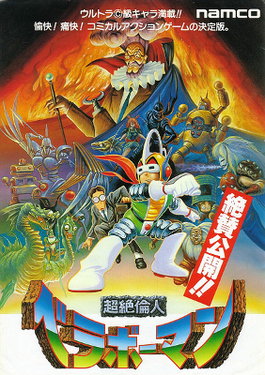
Chōzetsurin Jin Bravoman is a 1988 beat'em up arcade video game developed and published in Japan by Namco. Described as a "comical action game", the player controls the titular character, a bionic superhero with telescopic limbs, as he must defeat the villainous Dr. Bomb before he takes over the world. Bravoman can use his arms, legs and head to defeat enemies, and can also crouch and jump over them. The game ran on the Namco System 1 arcade board.

The Tower of Druaga is a 1984 arcade action role-playing maze game developed and published in Japan by Namco. Controlling the golden-armored knight Gilgamesh, the player is tasked with scaling 60 floors of the titular tower in an effort to rescue the maiden Ki from Druaga, a demon with eight arms and four legs, who plans to use an artifact known as the Blue Crystal Rod to enslave all of mankind. It ran on the Namco Super Pac-Man arcade hardware, modified with a horizontal-scrolling video system used in Mappy.
Namco Museum is a series of video game compilations developed and published by Bandai Namco Entertainment for home video game consoles. The first title in the series, Namco Museum Vol. 1, was released for the PlayStation in 1995. Entries in the series have been released for multiple platforms, including the Game Boy Advance, PlayStation 2, PlayStation Portable, Nintendo DS and Xbox 360. the latest being Namco Museum Archives Vol. 2, released in 2020.

Dig Dug II is an action arcade video game developed and published in Japan by Namco in 1985. It is a sequel to 1982's Dig Dug. Pookas and fire-breathing Fygars return as the enemies, but the side view tunneling of the original is replaced with an overhead view of an island maze.
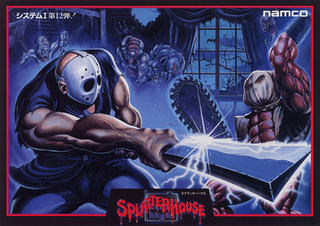
Splatterhouse is a beat 'em up arcade game developed and published by Namco in 1988. It was the first in a series of games released in home console and personal computer formats. This game would later spawn the parody Splatterhouse: Wanpaku Graffiti, the sequels Splatterhouse 2, Splatterhouse 3, and the 2010 remake Splatterhouse, with the classic games being added to Namco Museum since 2017.

Galaga '88 is a 1987 fixed shooter arcade video game by Namco. It is the third sequel to Galaxian. It features significantly improved graphics over the previous games in the series, including detailed backgrounds, larger enemies and greater ship details. The game runs on Namco System 1 hardware.
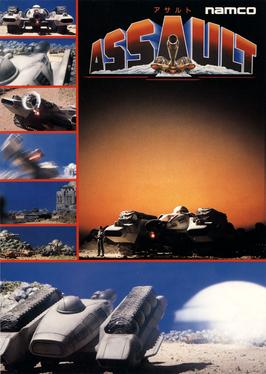
Assault is a 1988 multi-directional shooter arcade game developed and published by Namco. It was licensed to Atari Games for release in North America. Controlling a caterpillar-tread self-propelled gun, the player is tasked with completing each of the game's eleven stages while shooting enemies and avoiding projectiles. It uses a twin-stick control layout, similar to games such as Battlezone. The plot involves the human race searching for new planets after Earth reaches its maximum population - after discovering an exo-planet 35,000 light years away from the Milky Way, they enslave the planet's natives and take control, leading to the planet's native population vowing to abolish the humans and bring peace to their world. The protagonist who rides the aforementioned self-propelled gun which players control, is one such native.

Bakutotsu Kijūtei, also known by its longer title as Bakutotsu Kijūtei: Baraduke II, is a scrolling shooter arcade game that was released by Namco in 1988 only in Japan, and for the Virtual Console in 2009. It runs on Namco System 1 hardware, and is the sequel to Baraduke, which was released three years earlier. It was also the second game from the company to allow scores not ending in "0", along with the first one to display Katakana in bold text onscreen to distinguish it from Hiragana. The game would later be ported to the Wii Virtual Console in 2009 for Japan only.

Dragon Spirit is a 1987 vertical-scrolling shooter arcade game developed and published by Namco. In North America, it was distributed by Atari Games. Controlling the dragon Amur, the player must complete each of the game's nine areas to rescue the princess Alicia from the demon Zawell. Similar to Namco's own Xevious, Amur has a projectile weapon for destroying air-based enemies and a bomb for destroying ground enemies. It ran on the Namco System 1 arcade board.
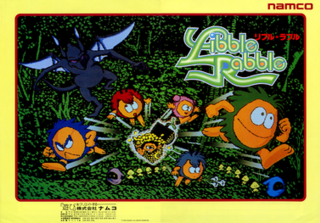
Libble Rabble is a 1983 puzzle arcade video game developed and published in Japan by Namco. The player is tasked with using two colored arrows, Libble and Rabble, to wrap them around pegs and surround small creatures known as Mushlins to "harvest" them under a time limit. The player can also uncover treasure chests that will have the player searching the stage for items in order to access a special bonus stage. It ran on the Namco Libble Rabble hardware, one of the only games to do so.

Yokai Dochuki is a 1987 platform arcade game developed and released by Namco in Japan and other parts of Asia. The player controls a young boy named Tarosuke as he must make his way through Jigoku, the Japanese concept of Hell, to reach Buddha, who will determine his fate. Tarosuke can fire small "ki" bullets at enemies to defeat them; he can also charge them to increase their power. Enemies will drop money when defeated, which can be used to purchase weapons and other items in stores. Two versions of the arcade original were released: a Japanese version and an English version which was released in other Asian countries outside Japan. The Arcade Archives release includes both versions.

Namco Classic Collection Vol. 1 is a 1995 arcade game compilation developed and published by Namco. It includes three of the company's most well-known games from the early 1980s — Galaga (1981), Xevious (1983), and Mappy (1983) — alongside brand-new "Arrangement" remakes of these games that have updated gameplay, visuals, and sounds. The arcade originals are also modified slightly to end after a certain number of rounds. Super Xevious (1984) is also playable. It ran on the Namco ND-1 arcade system, being one of the first games to utilize it.
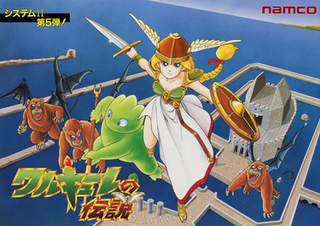
Valkyrie no Densetsu is a 1989 action-adventure role-playing arcade game developed and published in Japan by Namco. It is a follow-up to the Family Computer game Valkyrie no Bōken (1986). Players control the warrior maiden Valkyrie and her lizard-like companion Kurino Xandra as they set out to drop a mythical item called the Golden Seed into the Northern Fountain to replenish the dying crop fields of Xandra Land. Gameplay involves defeating enemies and collecting gold to purchase magical spells and weapons in shops.
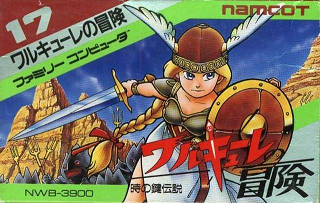
Valkyrie no Bōken: Toki no Kagi Densetsu is a video game developed and published by Namco. It was released in Japan for the Family Computer on August 1, 1986. It was also released for the Virtual Console of multiple Nintendo consoles, for the Wii on March 20, 2007, for the Nintendo 3DS on September 4, 2013 and for the Wii U on February 4, 2015.
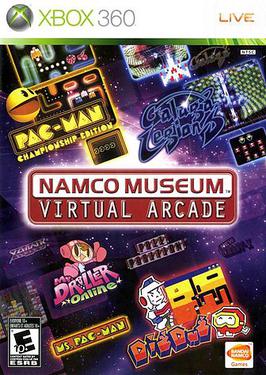
Namco Museum Virtual Arcade is a video game compilation developed and published by Namco Bandai Games for the Xbox 360. It was released in North America in 2008 and in Europe and Japan in 2009. Part of its Namco Museum series, Virtual Arcade includes 34 titles; nine of these are Namco Bandai-published Xbox Live Arcade games, and the rest are arcade games that are only accessible through the disc. Players can access the Xbox Live Arcade games through their dashboard if the disc is in the console.
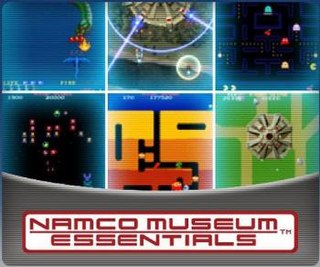
Namco Museum Essentials is a 2009 video game compilation developed by Cattle Call and published by Namco Bandai Games for the PlayStation 3. The collection includes five Namco arcade games from the 1980s: Pac-Man (1980), Galaga (1981), Dig Dug (1982), Xevious (1983), and Dragon Spirit (1987), alongside an exclusive Xevious sequel, Xevious Resurrection. Player progress is rewarded with stamps, which could be redeemed for virtual items in the now-defunct PlayStation Home service. Stamps also award points when collected, used to unlock extra features such as wallpapers.

Namcot Collection, also known as Namco Museum Archives, is a 2020 video game compilation published by Bandai Namco Entertainment. Originally released in Japan for the Nintendo Switch, it was localized for international territories as two separate collections, Namco Museum Archives Vol. 1 and Vol. 2, for the Switch, Xbox One, PlayStation 4, and Windows. Namcot Collection includes a wide array of video games published by Namco for the Family Computer and Nintendo Entertainment System, with save states, achievements, and homebrew ports of Pac-Man Championship Edition and Gaplus.




















